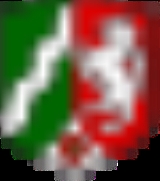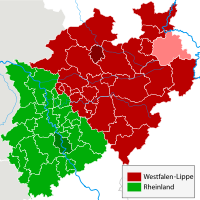
Coat of arms of North Rhine-Westphalia
Encyclopedia
The Coat of Arms of North Rhine-Westphalia is the official coat of arms
of the German
state
of North Rhine-Westphalia
.
 After World War II
After World War II
on August 23, 1946 the British military administration in Germany established the new state of North Rhine-Westphalia with the merger of the Province of Westphalia
and the northern parts of the Rhine Province
, to which in January 1947 the Free State of Lippe
was added. That same year Wolfgang Pagenstecher, a famous German heraldist
living in Düsseldorf
, made the original blazon for the newly created state, which adopted it on February 5, 1948. On March 10, 1953 this has been confirmed by the Law about the state's colours, the state's coat of arms and the state' s flag.
The named law starts as follows:
So the constituent three parts of this coat of arms are:
The coat of arms appears as a charge on the state flag of North Rhine-Westphalia
.
Coat of arms
A coat of arms is a unique heraldic design on a shield or escutcheon or on a surcoat or tabard used to cover and protect armour and to identify the wearer. Thus the term is often stated as "coat-armour", because it was anciently displayed on the front of a coat of cloth...
of the German
Germany
Germany , officially the Federal Republic of Germany , is a federal parliamentary republic in Europe. The country consists of 16 states while the capital and largest city is Berlin. Germany covers an area of 357,021 km2 and has a largely temperate seasonal climate...
state
States of Germany
Germany is made up of sixteen which are partly sovereign constituent states of the Federal Republic of Germany. Land literally translates as "country", and constitutionally speaking, they are constituent countries...
of North Rhine-Westphalia
North Rhine-Westphalia
North Rhine-Westphalia is the most populous state of Germany, with four of the country's ten largest cities. The state was formed in 1946 as a merger of the northern Rhineland and Westphalia, both formerly part of Prussia. Its capital is Düsseldorf. The state is currently run by a coalition of the...
.

World War II
World War II, or the Second World War , was a global conflict lasting from 1939 to 1945, involving most of the world's nations—including all of the great powers—eventually forming two opposing military alliances: the Allies and the Axis...
on August 23, 1946 the British military administration in Germany established the new state of North Rhine-Westphalia with the merger of the Province of Westphalia
Province of Westphalia
The Province of Westphalia was a province of the Kingdom of Prussia and the Free State of Prussia from 1815 to 1946.-History:Napoleon Bonaparte founded the Kingdom of Westphalia, which was a client state of the First French Empire from 1807 to 1813...
and the northern parts of the Rhine Province
Rhine Province
The Rhine Province , also known as Rhenish Prussia or synonymous to the Rhineland , was the westernmost province of the Kingdom of Prussia and the Free State of Prussia, within the German Reich, from 1822-1946. It was created from the provinces of the Lower Rhine and Jülich-Cleves-Berg...
, to which in January 1947 the Free State of Lippe
Free State of Lippe
The Free State of Lippe was a German state formed after the Principality of Lippe was abolished following the German Revolution of 1918.After the end of World War II, Lippe was restored from Nazi rule. This autonomy ended in January 1947 when British forces incorporated Lippe into the new German...
was added. That same year Wolfgang Pagenstecher, a famous German heraldist
Heraldry
Heraldry is the profession, study, or art of creating, granting, and blazoning arms and ruling on questions of rank or protocol, as exercised by an officer of arms. Heraldry comes from Anglo-Norman herald, from the Germanic compound harja-waldaz, "army commander"...
living in Düsseldorf
Düsseldorf
Düsseldorf is the capital city of the German state of North Rhine-Westphalia and centre of the Rhine-Ruhr metropolitan region.Düsseldorf is an important international business and financial centre and renowned for its fashion and trade fairs. Located centrally within the European Megalopolis, the...
, made the original blazon for the newly created state, which adopted it on February 5, 1948. On March 10, 1953 this has been confirmed by the Law about the state's colours, the state's coat of arms and the state' s flag.
The named law starts as follows:
So the constituent three parts of this coat of arms are:
- dexter: Vert a bend sinster wavy Argent, which is a reflection of the former coat of arms of the Rhine ProvinceRhine ProvinceThe Rhine Province , also known as Rhenish Prussia or synonymous to the Rhineland , was the westernmost province of the Kingdom of Prussia and the Free State of Prussia, within the German Reich, from 1822-1946. It was created from the provinces of the Lower Rhine and Jülich-Cleves-Berg...
. This until than showed a bend wavy, representing the river Rhine flowing through the RhinelandRhinelandHistorically, the Rhinelands refers to a loosely-defined region embracing the land on either bank of the River Rhine in central Europe....
, today's southwestern part of the state. The change from bend to bend sinister has only been done because of aestheticalAestheticsAesthetics is a branch of philosophy dealing with the nature of beauty, art, and taste, and with the creation and appreciation of beauty. It is more scientifically defined as the study of sensory or sensori-emotional values, sometimes called judgments of sentiment and taste...
reasons. - sinister: Gules a horse rampant Argent, as opposed to the jumping horse in the arms of Lower SaxonyLower SaxonyLower Saxony is a German state situated in north-western Germany and is second in area and fourth in population among the sixteen states of Germany...
, representing WestphaliaWestphaliaWestphalia is a region in Germany, centred on the cities of Arnsberg, Bielefeld, Dortmund, Minden and Münster.Westphalia is roughly the region between the rivers Rhine and Weser, located north and south of the Ruhr River. No exact definition of borders can be given, because the name "Westphalia"...
, the northeastern part of the state. Originally it was the Saxon steedSaxon SteedThe Saxon Steed is a favorite heraldic motif of the Saxons.-Origin and past uses:The Saxon Steed originated in the tribal Duchy of Saxony...
, the emblem of the Saxon stern duchy. It is identical to the preceding coat of arms of the Province of WestphaliaProvince of WestphaliaThe Province of Westphalia was a province of the Kingdom of Prussia and the Free State of Prussia from 1815 to 1946.-History:Napoleon Bonaparte founded the Kingdom of Westphalia, which was a client state of the First French Empire from 1807 to 1813...
. - enté en point embowed: Argent a rose Gules seeded and leaved Or, showing the rose of Lippe. This was the coat of arms of the Principality of LippePrincipality of LippeLippe was a historical state in Germany. It was located between the Weser River and the southeast part of the Teutoburg forest.-History:...
, now the district of LippeLippeLippe is a Kreis in the east of North Rhine-Westphalia, Germany. Neighboring districts are Herford, Minden-Lübbecke, Höxter, Paderborn, Gütersloh, and district-free Bielefeld, which forms the region Ostwestfalen-Lippe....
in the east of the state.
The coat of arms appears as a charge on the state flag of North Rhine-Westphalia
Flag of North Rhine-Westphalia
The flag of North-Rhine Westphalia is the flag of the German state of North-Rhine Westphalia.After the establishment of North-Rhine Westphalia in 1946, this flag had been in use since 1948 although it was not formally established until 1953. The plain tricolour is the state's civil flag...
.
See also
- List of coats of arms of the districts in North Rhine-Westphalia
- Coat of arms of PrussiaCoat of arms of PrussiaThe state of Prussia developed from the State of the Teutonic Order. The original flag of the Teutonic Knights had been a black cross on a white flag.Emperor Frederick II in 1229 granted them the right to use the black Eagle of the Holy Roman Empire....
- Coat of arms of GermanyCoat of arms of GermanyThe coat of arms of Germany displays a black eagle on a yellow shield ....
- Origin of the coats of arms of German federal states.

